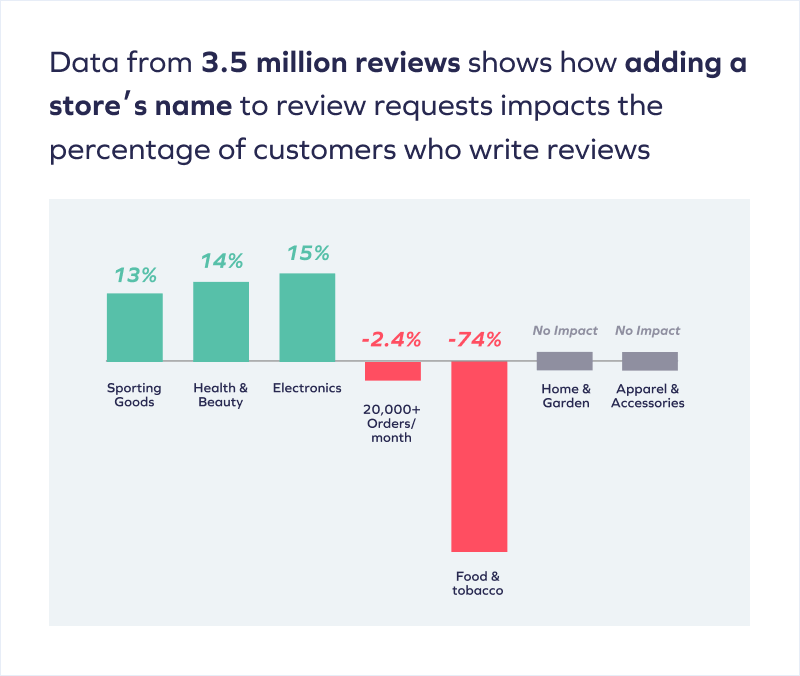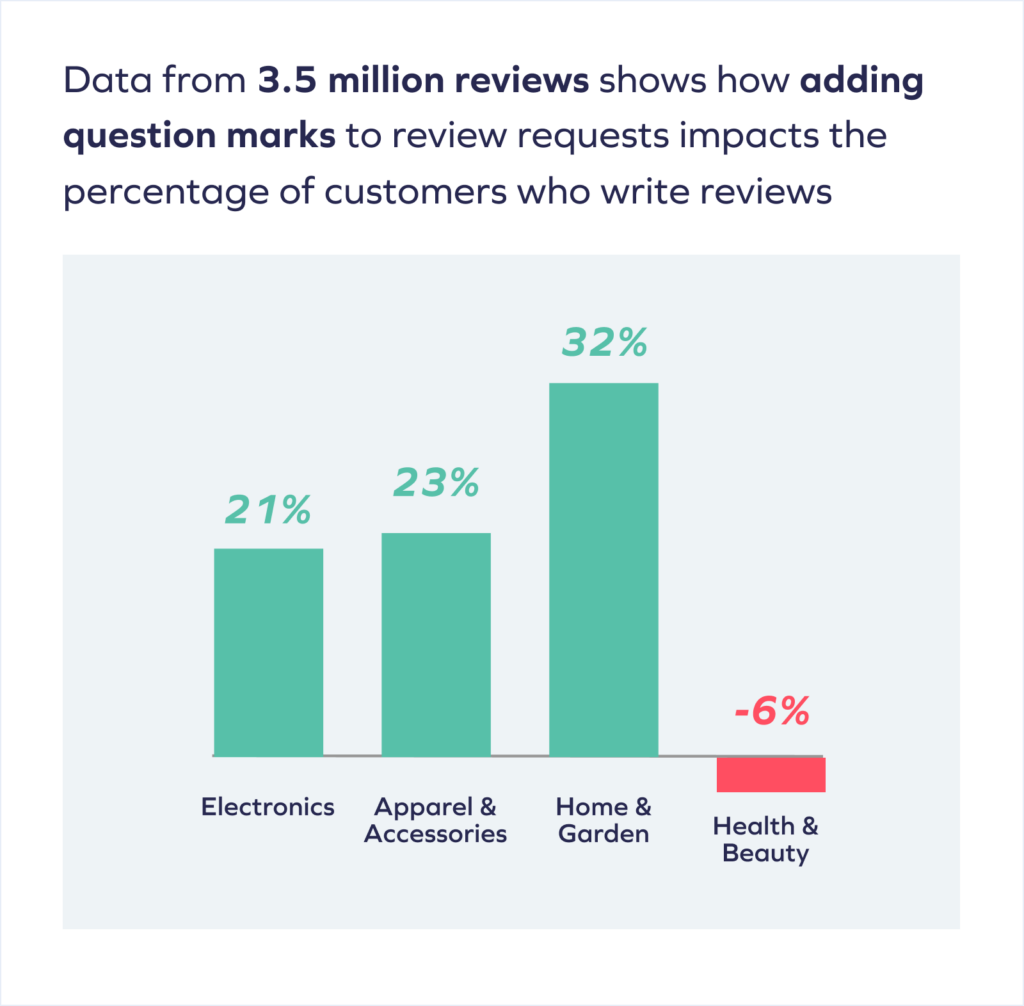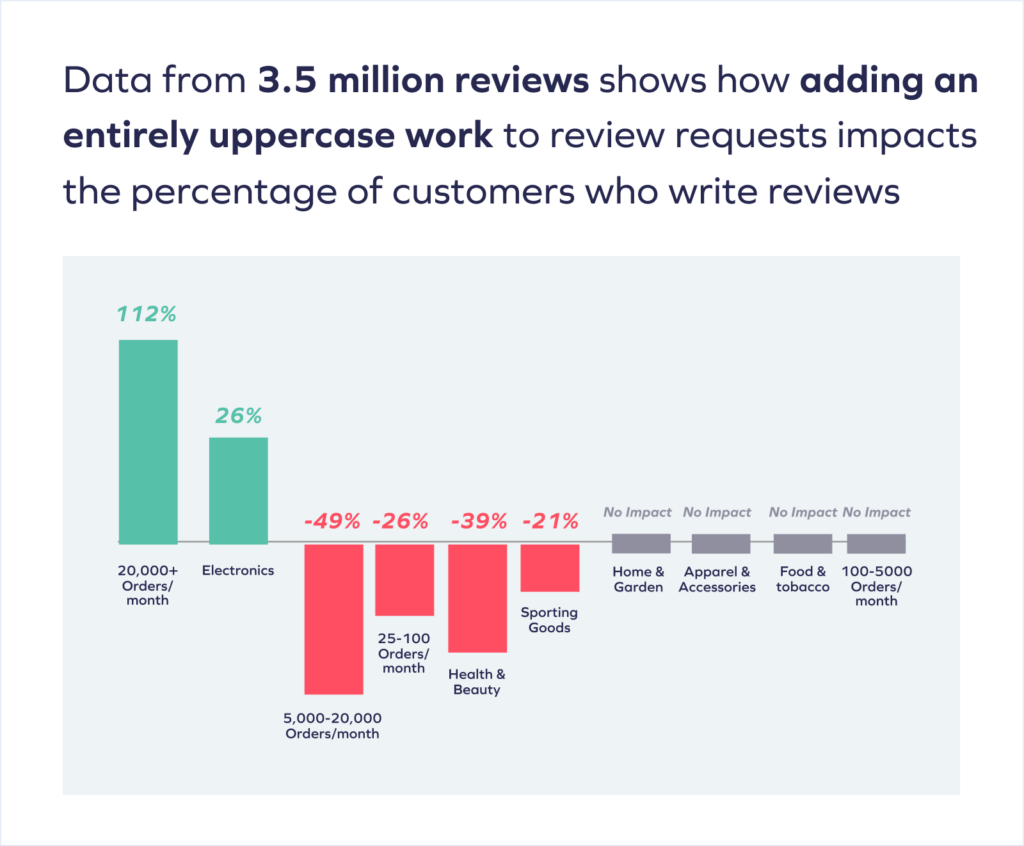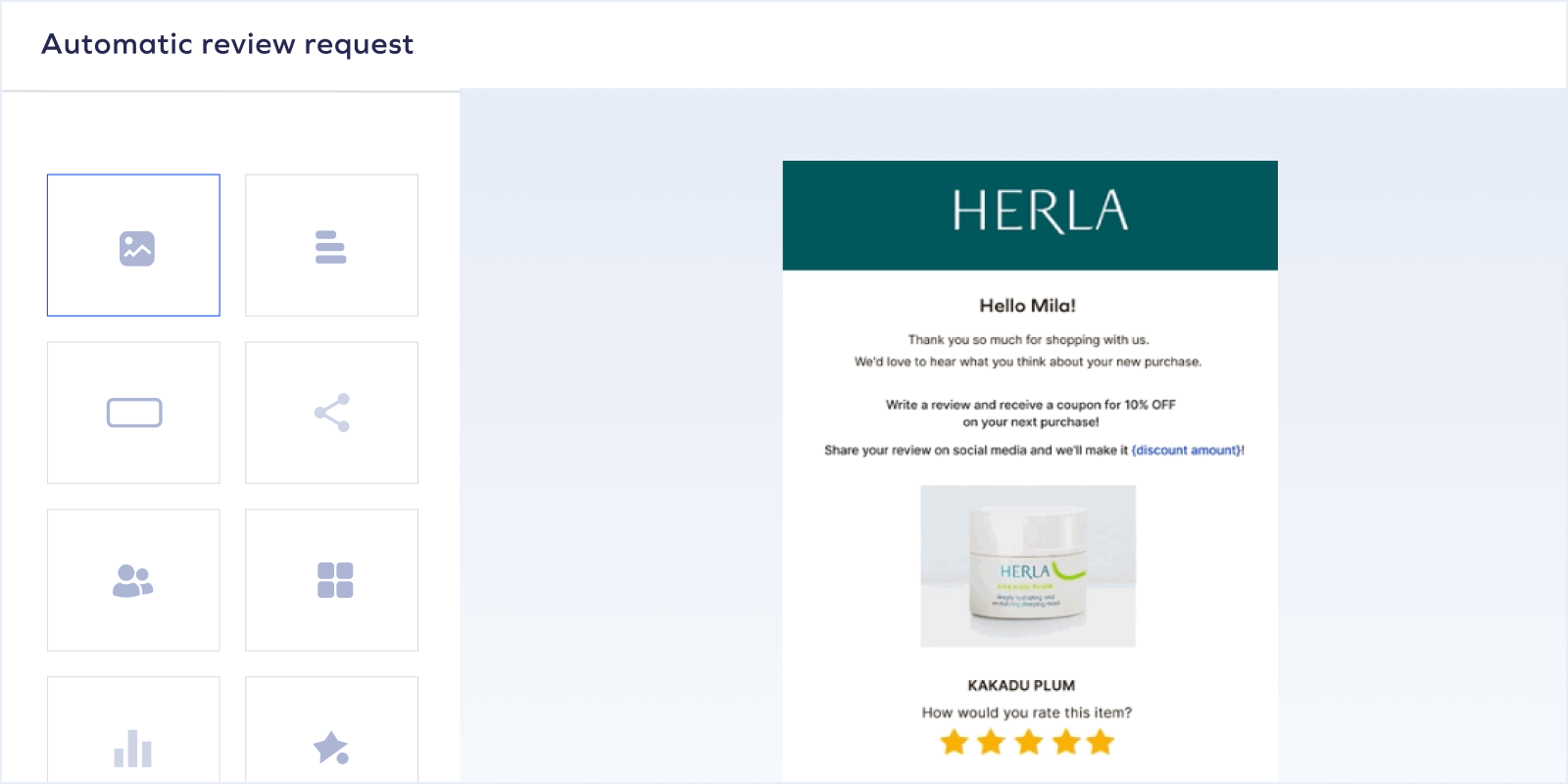When asking for reviews, it’s critical to find the right balance of catchy subject lines; fun, personalized messaging, and eye-catching branded email designs. With these elements in place, you can boost your review conversion rate.
While on a mission to learn more about what drives shoppers to convert within review request emails, we took a look at the messaging within subject lines and the requests themselves.
Let’s explore some best practices on how to ask for a review and how you can enhance your requests with our new no-code email editor and email template library.
The benefits of asking for reviews
Why should eCommerce brands collect customer reviews in the first place?
There are many benefits to sending a review request and having the ability to share those reviews on your eCommerce site, but here are just a few to keep in mind.
Reviews boost buyer confidence
Customer reviews can increase sales conversion rates. Shoppers like seeing user-generated content (UGC) on a brand’s site as it allows them to determine if your products are the right fit for them. With reviews, you can display social proof from existing customers who have purchased and are satisfied with your product — nudging new shoppers to complete their purchase.
Reviews can be used to improve your products
Negative reviews can provide opportunities to improve your products. Use customer feedback to identify friction points in your customer experience. For example, collecting reviews from customers that include details about product fit, quality, or shipping issues, can provide actionable insights that allow you to make adjustments to your products, processes, or on-site descriptions.
Reviews help with SEO and search results
Up-to-date reviews are essential for ranking highly on Google, especially as an eCommerce brand. Getting those reviews and ratings front and center on search, and leveraging SEO, can help you stand out from the competition.
How to ask customers for reviews
Your brand’s messaging can make a big impact on how customers engage with a review request, leading to more thoughtful reviews about your products and your brand in general. Here are some stand out ways to ask for reviews:
1. Leverage email and SMS for review requests
Email and SMS review requests work exceptionally well together when done correctly. If one channel is better suited for certain customers or customer actions, it can fill in whatever gaps the other channel has left. This provides a well-rounded and powerful marketing strategy that reaches your customers at the right moment on the correct devices.
2. Send timely review requests
Sending review requests in a timely manner or following up with your shoppers if you haven’t received a review after your first request can help encourage customers to submit a review. It’s important that you ensure you’re asking for reviews after your product has been delivered. In this case, keeping track of shipping and delivery and then adjusting the timelines that trigger your Automatic Review Request flows can help with this
3. Respond to your reviews — even the negative ones
While receiving a negative review might feel difficult at first, responding to a negative review and engaging with your customers is critical. Responding to a negative review gives your brand a chance to remedy any issues the customer had with their shopping experience. This can help reduce churn, build brand trust, and showcase your brand’s authenticity.
How to ask for a review: Best practices on subject lines and messaging
Getting more reviews requires thoughtfulness, and small changes can lead to big results. With that, it’s crucial to maintain branding throughout your messaging — including subject lines when you’re asking for reviews.
We studied the subject lines of 3.5 million post-purchase review request emails and compared their conversion rates to the average to find out what works and what doesn’t when asking for reviews. To further build off of the insights surrounding how to ask customers for reviews, let’s explore some best practices in subject lines and overall messaging.
Maintain your branding by including your store name
Adding your store or business name to the subject line boosts conversion by 3.7% on average, but sometimes it corresponds with a significant decrease.
The industries that benefit the most from including their store name are Health & Beauty, Home & Garden, Sporting Goods, and Electronics. But Food & Tobacco brands see a big decrease (74%) if they add the store name to subject lines. Size-wise, the stores that don’t benefit from adding their name in subject lines are stores with over 20,000 orders.

Connect your loyalty program to your reviews
Brands can incentivize reviews by offering loyalty points and using discounts or coupons. However, per FTC regulations, it’s important to make sure you understand the ins and outs of incentivizing reviews. For instance, you should not incentivize customers to submit positive reviews in order to redeem any loyalty points or discounts.
Ask your customers a question
Our research found that asking questions is a great way to gather more reviews. In fact, including question marks in review request subject lines lead to an average increase of 15.7%. Interestingly, the bigger the store, the more of an impact adding a question mark has. Only one industry saw negative results (Health & Beauty), but the impact is very minimal.

Use exclamation points
In general, for brands with under 5,000 orders, exclamation points don’t exhibit a direct impact, while stores with over 5,000 orders tend to see a more positive impact (about 18%). However, for very small businesses (under 100 monthly orders) or larger, enterprise businesses (over 100,000 monthly orders), there’s actually a slightly negative impact.
When it comes to industry, the most astonishing difference is when it comes to Food & Tobacco stores. For these stores, adding exclamations can lead to an 83.5% increase. Adding a question mark barely increased the conversion rate of a shopper to a reviewer in this industry, so it’s surprising to see what a huge impact changing punctuation to an exclamation point has.
The Food & Tobacco industry’s results are even more surprising when you consider that the second most impacted industry is Health & Beauty, which gets a 30.4% increase. That means adding exclamation points increases Food & Tobacco stores’ review conversion rate nearly three times more than any other industry.
Be mindful of capitalization
Capitalizing all of the words in a subject line showed a slight decrease in the overall review conversion rate: 5.8% on average. The only industry that benefits significantly is Electronics, which has a 26.7% increase. The industries that should definitely avoid capitalizing all words in their subject lines are Health & Beauty (39% decrease) and Sporting Goods (21% decrease).
For stores with under 20,000 monthly orders, adding a word in all caps can lower conversion by 49.3%. Interestingly, stores with more than 20,000 orders see an enormous increase when they add capitalization: 112.6%

Leverage 2-in-1 Review Requests
While brands need to be reasonable and efficient with what they ask their customers for, they should also keep in mind that they need two types of reviews: product reviews and site reviews.
The latter is needed to obtain their Google Seller Rating (GSR) faster, which directly impacts conversion, product discovery, and more. Instead of overloading your review request emails, you can use Yotpo’s 2-in-1 Review Requests, which prompts users to leave a site review after completing a product review.
Beware of emotional appeals in subject lines
Including emotional words — like “love,” “smile,” “happy,” or “help” — don’t have a major impact on getting customers to leave reviews. When it comes to the breakdown by store size, smaller brands (with 25-100 orders/month) and large brands (with 20,000+ orders/month) both see a negative impact, while midsized brands (between 100-20,000 orders/month) don’t see any major impact.
Industry-wise, Health & Beauty, Electronics, and Sporting Goods also see a negative impact from having emotional words in subject lines; the review conversion rate can be up to 41% lower. In contrast, Home & Garden businesses see an increase in review conversion when they include emotional keywords. The conversion rate is 28% higher on average. This could be because consumers are more emotionally attached to items they buy for their home than they are to items like computers or baseball bats.
With the subject line best practices above, you can really set your brand up for success. And you can take your review requests to the next level with our no-code email editor.
Yotpo’s no-code email editor
If you’re looking to encourage your shoppers to submit a review via email, our no-code email editor will allow you to create beautifully designed review request emails that convert.
The editor’s drag-and-drop functionality makes it easy to create on-brand emails. And with our new brand kit, you can customize the look and feel of your emails by applying your brand’s unique colors, fonts, and more.

How to ask for a review: Email and SMS templates
Our email template library allows you to add an extra layer of customization to your review request emails. With our library of high-converting templates, you can launch review request emails with ease. Here’s an example of one of our new templates:

Here are additional review request email and SMS templates to boost engagement as well as your review conversion rates.
How to ask customers for a review: email templates
Email copy 1:
Subject line: How’s your new {product_name} from {brand_name}?
Hi {customer_name},
Thanks for your recent purchase!
Now that you’ve had some time to use your new {product_name}, we would love to hear your thoughts. What did you think?
CTA button: Write a review
Thank you!
{brand_name}
Email copy 2:
Subject line: Share your feedback on {product_name}
Hi {customer_name},
We hope you’re loving your new {product_name}! Share your thoughts with us in a review.
CTA button: Write a review
We appreciate your feedback!
Thank you,
{brand_name}
How to ask customers for a review: SMS templates
SMS copy 1:
{brand_name}: Thanks for your recent purchase. Don’t forget to share your feedback on your new {product_name}.
Submit your review here: {insert_link}
SMS copy 2:
Hi {customer_name}, We hope you’re enjoying your new {product_name}.
Click here to leave a review and earn a 10% discount on your next purchase: {insert_link}
When it comes to adapting this template for your needs, don’t be afraid to get creative and show your brand personality. Make sure it matches the tone you use across your site, and don’t shy away from bringing a sense of community to the copy.
Customers respond to the right messaging
Customers are overwhelmed with spam and offers and generally just block it out; it can seem like they only provide feedback when it’s negative. But many are eager to share their satisfaction, too; they just need a nudge, and sometimes a reminder. With the right requests, you’ll gain valuable feedback all while boosting your visibility and sales.













